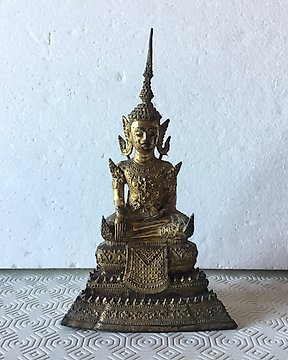
Boeddha - Rattanakosin - Rama VI - VII - Thailand (Zonder Minimumprijs)
Nr. 82156067

Nr. 82156067

Walking Buddha from Thailand, traces of gilt.
This form of the Buddha is a typical Thai iconic invention that emerged in Thai bronze sculpture in the 14th century. At Sukhothai it is known as caṅkrama where it refers to the pacing of Buddha during the third week after his Enlightenment. Caṅkrama (चङ्क्रम) refers to “walking”, according to Mahāprajñāpāramitāśāstra (chapter 3). In early Buddhist art at Sañcī and Bhārhūt (early 1st century b.C.), the walking Buddha is symbolically represented by a meditation path which is also called caṅkrama. One of the earliest representations of a walking Buddha is found on a lintel from Takht-I-Bahi in Pakistan (2nd-3rd century AD). Walking of the Buddha might be a significant symbol of his rejection of his royal life and thus of his alternative destiny as a universal King as described in the Suttanipāta. Kings and Gods do not usually walk. The earliest known representation of the walking Buddha in Southeast Asia is from Wat Benchamabopit, Sukhothai area, 14th century AD.
This large bronze Buddha with traces of gilt is depicted here in mid-stride, his left foot forward, and left hand in abhayamudrā (gesture of fearlessness, a hand gesture where the hand is held upright with the palm facing outward).
On a wooden stand (included)
Height 35 cm (30 without stand)
Provenance:
Lempertz Auctioneers
Private German Collection
BVA Auctioneers
Zo koop je op Catawiki
1. Ontdek iets bijzonders
2. Plaats het hoogste bod
3. Veilig betalen